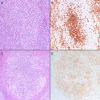Pathologic and molecular insights in nodal T-follicular helper cell lymphomas
- PMID: 36793612
- PMCID: PMC9923156
- DOI: 10.3389/fonc.2023.1105651
Pathologic and molecular insights in nodal T-follicular helper cell lymphomas
Abstract
T-follicular helper (TFH) cells are one of the T-cell subsets with a critical role in the regulation of germinal center (GC) reactions. TFH cells contribute to the positive selection of GC B-cells and promote plasma cell differentiation and antibody production. TFH cells express a unique phenotype characterized by PD-1hi, ICOShi, CD40Lhi, CD95hi, CTLAhi, CCR7lo, and CXCR5hi . Three main subtypes of nodal TFH lymphomas have been described: 1) angioimmunoblastic-type, 2) follicular-type, and 3) not otherwise specified (NOS). The diagnosis of these neoplasms can be challenging, and it is rendered based on a combination of clinical, laboratory, histopathologic, immunophenotypic, and molecular findings. The markers most frequently used to identify a TFH immunophenotype in paraffin-embedded tissue sections include PD-1, CXCL13, CXCR5, ICOS, BCL6, and CD10. These neoplasms feature a characteristic and similar, but not identical, mutational landscape with mutations in epigenetic modifiers (TET2, DNMT3A, IDH2), RHOA, and T-cell receptor signaling genes. Here, we briefly review the biology of TFH cells and present a summary of the current pathologic, molecular, and genetic features of nodal lymphomas. We want to highlight the importance of performing a consistent panel of TFH immunostains and mutational studies in TCLs to identify TFH lymphomas.
Keywords: angioimmunoblastic T cell lymphoma; follicular T helper; molecular and genetic profiling; next-generation sequencing; peripheral T cell lymphomas.
Copyright © 2023 Marques-Piubelli, Amador and Vega.
Conflict of interest statement
FV receives research funding from CRISPR Therapeutics, Allogene Therapeutics, and Geron Corporation. The remaining authors declare that the research was conducted in the absence of any commercial or financial relationships that could be construed as a potential conflict of interest.
Figures



Similar articles
-
Primary cutaneous peripheral T-cell lymphomas with a T-follicular helper phenotype: an integrative clinical, pathological and molecular case series study.Br J Dermatol. 2022 Dec;187(6):970-980. doi: 10.1111/bjd.21791. Epub 2022 Sep 2. Br J Dermatol. 2022. PMID: 35895386 Free PMC article.
-
Comprehensive analysis of clinical, pathological, and genomic characteristics of follicular helper T-cell derived lymphomas.Exp Hematol Oncol. 2021 May 14;10(1):33. doi: 10.1186/s40164-021-00224-3. Exp Hematol Oncol. 2021. PMID: 33990228 Free PMC article.
-
The pathological features of angioimmunoblastic T-cell lymphomas with IDH2R172 mutations.Mod Pathol. 2019 Jul;32(8):1123-1134. doi: 10.1038/s41379-019-0254-4. Epub 2019 Apr 5. Mod Pathol. 2019. PMID: 30952970
-
Recent Progress in the Understanding of Angioimmunoblastic T-cell Lymphoma.J Clin Exp Hematop. 2017;57(3):109-119. doi: 10.3960/jslrt.17019. J Clin Exp Hematop. 2017. PMID: 29279549 Free PMC article. Review.
-
Neoplasms of follicular helper T-cells: an insight into the pathobiology.Am J Blood Res. 2022 Jun 20;12(3):64-81. eCollection 2022. Am J Blood Res. 2022. PMID: 35873103 Free PMC article. Review.
Cited by
-
Mechanisms of lymphoma-stromal interactions focusing on tumor-associated macrophages, fibroblastic reticular cells, and follicular dendritic cells.J Clin Exp Hematop. 2024 Sep 28;64(3):166-176. doi: 10.3960/jslrt.24034. Epub 2024 Jul 31. J Clin Exp Hematop. 2024. PMID: 39085126 Free PMC article. Review.
-
New insights into the biology of T-cell lymphomas.Blood. 2024 Oct 31;144(18):1873-1886. doi: 10.1182/blood.2023021787. Blood. 2024. PMID: 39213420 Review.
-
Advances in peripheral T cell lymphomas: pathogenesis, genetic landscapes and emerging therapeutic targets.Histopathology. 2025 Jan;86(1):119-133. doi: 10.1111/his.15376. Histopathology. 2025. PMID: 39679758 Free PMC article. Review.
-
Clinicopathologic analysis of nodal T-follicular helper cell lymphomas, a multicenter retrospective study from China.Front Immunol. 2024 Mar 27;15:1371534. doi: 10.3389/fimmu.2024.1371534. eCollection 2024. Front Immunol. 2024. PMID: 38601148 Free PMC article.
References
-
- de Leval L, Rickman DS, Thielen C, Reynies A, Huang YL, Delsol G, et al. . The gene expression profile of nodal peripheral T-cell lymphoma demonstrates a molecular link between angioimmunoblastic T-cell lymphoma (AITL) and follicular helper T (TFH) cells. Blood (2007) 109(11):4952–63. doi: 10.1182/blood-2006-10-055145 - DOI - PubMed
-
- Piccaluga PP, Agostinelli C, Califano A, Carbone A, Fantoni L, Ferrari S, et al. . Gene expression analysis of angioimmunoblastic lymphoma indicates derivation from T follicular helper cells and vascular endothelial growth factor deregulation. Cancer Res (2007) 67(22):10703–10. doi: 10.1158/0008-5472.CAN-07-1708 - DOI - PubMed
-
- Dobay MP, Lemonnier F, Missiaglia E, Bastard C, Vallois D, Jais JP, et al. . Integrative clinicopathological and molecular analyses of angioimmunoblastic T-cell lymphoma and other nodal lymphomas of follicular helper T-cell origin. Haematologica (2017) 102(4):e148–51. doi: 10.3324/haematol.2016.158428 - DOI - PMC - PubMed
Publication types
LinkOut - more resources
Full Text Sources
Research Materials
Miscellaneous

